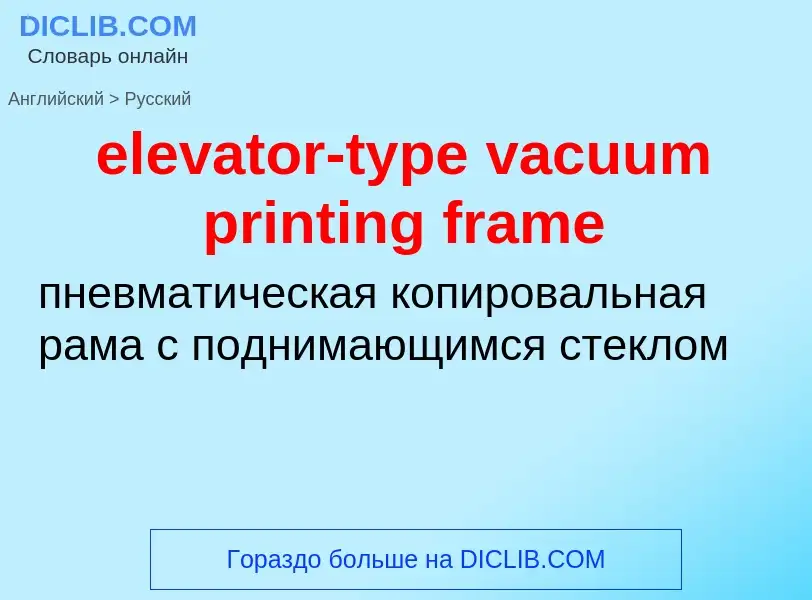Перевод и анализ слов искусственным интеллектом ChatGPT
На этой странице Вы можете получить подробный анализ слова или словосочетания, произведенный с помощью лучшей на сегодняшний день технологии искусственного интеллекта:
- как употребляется слово
- частота употребления
- используется оно чаще в устной или письменной речи
- варианты перевода слова
- примеры употребления (несколько фраз с переводом)
- этимология
elevator-type vacuum printing frame - перевод на русский
общая лексика
ручной набор
Википедия

Movable type (US English; moveable type in British English) is the system and technology of printing and typography that uses movable components to reproduce the elements of a document (usually individual alphanumeric characters or punctuation marks) usually on the medium of paper.
The world's first movable type printing technology for paper books was made of porcelain materials and was invented around AD 1040 in China during the Northern Song dynasty by the inventor Bi Sheng (990–1051). The earliest printed paper money with movable metal type to print the identifying code of the money was made in 1161 during the Song dynasty. In 1193, a book in the Song dynasty documented how to use the copper movable type. The oldest extant book printed with movable metal type, Jikji, was printed in Korea in 1377 during the Goryeo dynasty.
The spread of both movable-type systems was, to some degree, limited to primarily East Asia. The development of the printing press in Europe may have been influenced by various sporadic reports of movable type technology brought back to Europe by returning business people and missionaries to China. Some of these medieval European accounts are still preserved in the library archives of the Vatican and Oxford University among many others.
Around 1450, German goldsmith Johannes Gutenberg introduced the metal movable-type printing press in Europe, along with innovations in casting the type based on a matrix and hand mould. The small number of alphabetic characters needed for European languages was an important factor. Gutenberg was the first to create his type pieces from an alloy of lead, tin, and antimony—and these materials remained standard for 550 years.
For alphabetic scripts, movable-type page setting was quicker than woodblock printing. The metal type pieces were more durable and the lettering was more uniform, leading to typography and fonts. The high quality and relatively low price of the Gutenberg Bible (1455) established the superiority of movable type in Europe and the use of printing presses spread rapidly. The printing press may be regarded as one of the key factors fostering the Renaissance and, due to its effectiveness, its use spread around the globe.
The 19th-century invention of hot metal typesetting and its successors caused movable type to decline in the 20th century.


![Ceramic type from the collections of [[University of Reading]]. Ceramic type from the collections of [[University of Reading]].](https://commons.wikimedia.org/wiki/Special:FilePath/Ceramic type 02.jpg?width=200)
![Wang Zhen]]'s book published in 1313 Wang Zhen]]'s book published in 1313](https://commons.wikimedia.org/wiki/Special:FilePath/Chinese movable type 1313-ce.png?width=200)
![Korean movable type from 1377 used for the ''[[Jikji]]'' Korean movable type from 1377 used for the ''[[Jikji]]''](https://commons.wikimedia.org/wiki/Special:FilePath/JikjiType.gif?width=200)
![The intricate frontispiece of the ''[[Diamond Sutra]]'' from [[Tang dynasty]] China, the oldest extant woodblock-printed book, AD 868 ([[British Museum]]) The intricate frontispiece of the ''[[Diamond Sutra]]'' from [[Tang dynasty]] China, the oldest extant woodblock-printed book, AD 868 ([[British Museum]])](https://commons.wikimedia.org/wiki/Special:FilePath/Jingangjing.jpg?width=200)
![The [[King of Na gold seal]], bestowed by [[Emperor Guangwu of Han]] to Wana (Yayoi Japan) in 57 AD. The [[King of Na gold seal]], bestowed by [[Emperor Guangwu of Han]] to Wana (Yayoi Japan) in 57 AD.](https://commons.wikimedia.org/wiki/Special:FilePath/King of Na gold seal.jpg?width=200)
![Printed pages of the ''[[Jikji]]'' Printed pages of the ''[[Jikji]]''](https://commons.wikimedia.org/wiki/Special:FilePath/Korean book-Jikji-Selected Teachings of Buddhist Sages and Seon Masters-1377.jpg?width=200)
![Sort]]. Sort]].](https://commons.wikimedia.org/wiki/Special:FilePath/Long S-I Garamond sort 001.png?width=200)
![A case of cast metal type pieces and typeset matter in a [[composing stick]] A case of cast metal type pieces and typeset matter in a [[composing stick]]](https://commons.wikimedia.org/wiki/Special:FilePath/Metal movable type.jpg?width=200)
![Jin dynasty]]) with bronze movable type counterfeit markers Jin dynasty]]) with bronze movable type counterfeit markers](https://commons.wikimedia.org/wiki/Special:FilePath/五贯宝卷.jpg?width=200)

